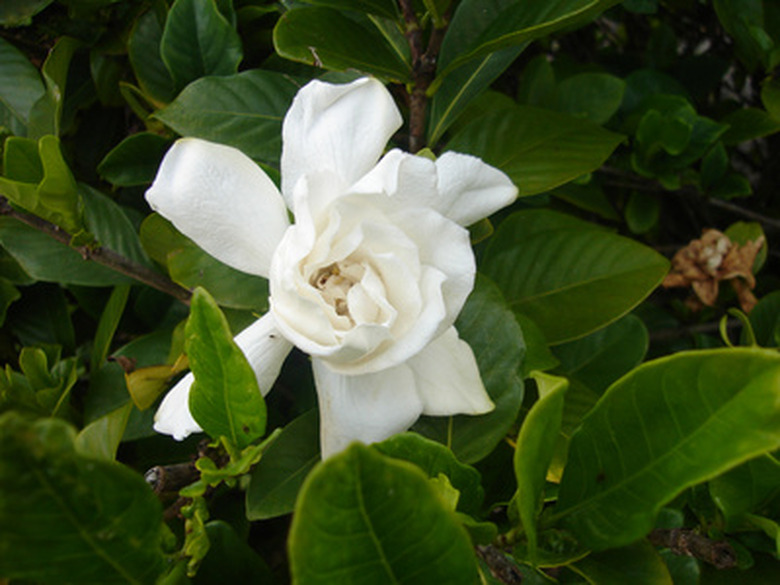Black Mold On A Gardenia Bush
Black mold can cover the leaves of the gardenia bush with a blackish, sticky substance that can be wiped away. Insects are the reasons for black mold on a gardenia bush. The mold slows down the food production of the leaves. White flies, aphids, scale bugs and mealy bugs are the most common culprits. They excrete excess sugary moisture from the leaves, causing the mold to form on the gardenia bush.
Effects of Mold
Mold is the Ascomyete, or fungus, that forms from the sugary secretions of insects. Mold does not infect the gardenia plant, but covers it with a black soot. The mold spores from the air get stuck on the secretions the bugs pull from the leaves. Those mold spores begin to germinate and produce the black fungal strands that adhere to the leaves of the gardenia plant.
- Black mold can cover the leaves of the gardenia bush with a blackish, sticky substance that can be wiped away.
- They excrete excess sugary moisture from the leaves, causing the mold to form on the gardenia bush.
Once the fungus starts to cover the plant, it lowers the amount of sunlight that hits the plant tissue. This decreases food production, causing the gardenia plant to reduce its growth. Washing the mold off the gardenia plant is easy, but if the secretions are still on the plant or bugs are left, you will see it again in just a few days. Check new growth of leaves often, as the bugs prefer the tender young leaves of the gardenia plant.
Treating Infected Gardenias
Start treatment by using an insecticidal soap, dish soap or laundry detergent. Okaloosa University IFAS Extension recommends that you use one tablespoon of soap per gallon of water. Dissolve soap in water and spray the plant. Make sure to spray under the leaves of the gardenia. Let it sit for an hour and wash away with fresh water. This will remove the mold and part of the pests.
- Once the fungus starts to cover the plant, it lowers the amount of sunlight that hits the plant tissue.
- Washing the mold off the gardenia plant is easy, but if the secretions are still on the plant or bugs are left, you will see it again in just a few days.
You can then use an insecticide to finish the process of killing the infecting bugs. Use common pesticides like Orthene, Malathion or Diazinon. Follow the instructions on the fungicides carefully. Do not use these on plants that produce fruits or vegetables. If you prefer organic sprays, there are many made with Neem oil. Neem oil is biodegradable and will not harm birds, mammals, bees or earthworms.
Preventing Mold
To prevent mold from infesting the gardenia bush, start controlling the mold before it causes a problem. Unless you look really close, you may not see the pests on the gardenia leaves. You can't see the effects on the leaves right away because these bugs do not have the ability to chew. Check for new leaves that may be distorted and start treatment for pests immediately.
- You can then use an insecticide to finish the process of killing the infecting bugs.
- Unless you look really close, you may not see the pests on the gardenia leaves.
Early Intervention
It takes around 2-3 weeks for black, sooty mold to appear after infestation by insects. The most successful method of preventing mold on a gardenia plant is early intervention. However, this method of prevention is time-consuming. It requires constant care and vigilance to keep the insects out.
As soon as insects are discovered, treatment should begin at once. As an extra precaution, use ladybugs to help keep insects off the gardenia plant. Ladybugs eat aphids and and white flies. You can purchase ladybugs from a local hardware store and put them in the garden.
- It takes around 2-3 weeks for black, sooty mold to appear after infestation by insects.
- As an extra precaution, use ladybugs to help keep insects off the gardenia plant.
Locating the Insects
White flies are the most common cause of black mold on gardenias. To identify an infestation of white flies, hold a piece of white paper under a leaf of the gardenia. Shake the leaf gently. Fold the paper in half and squeeze tightly along the crease of the fold. Open the paper and look for any signs of insects. Sometimes, a black or red spot will appear on the paper where a white fly was squashed.
